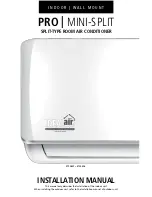
SERVICING
36
S-1 CHECKING VOLTAGE
1. Remove outer case, control panel cover, etc., from unit
being tested.
With power ON:
WARNING
Line Voltage now present.
2. Using a voltmeter, measure the voltage across terminals
L1 and L2 of the contactor for the condensing unit or at the
field connections for the air handler or heaters.
ComfortNet
TM
Ready Condensing Units:
Measure the
voltage across the L1 and L2 lugs on the unitary (UC)
control.
3. No reading - indicates open wiring, open fuse(s) no power
or etc., from unit to fused disconnect service. Repair as
needed.
4. With ample voltage at line voltage connectors, energize
the unit.
5. Measure the voltage with the unit starting and operating,
and determine the unit Locked Rotor Voltage.
NOTE
: If
checking heaters, be sure all heating elements are
energized.
Locked Rotor Voltage
is the actual voltage available at
the compressor during starting, locked rotor, or a stalled
condition. Measured voltage should be above minimum
listed in chart below.
To measure Locked Rotor Voltage attach a voltmeter to
the run "R" and common "C" terminals of the compressor,
or to the T
1
and T
2
terminals of the contactor. Start the unit
and allow the compressor to run for several seconds, then
shut down the unit. Immediately attempt to restart the
unit while measuring the Locked Rotor Voltage.
ComfortNet Ready Condensing Units:
To measure the
Locked Rotor Voltage, attach a voltmeter to the run "R"
and common "C" terminals of the compressor or across
the "R" and "C" lugs on the unitary (UC) control. Start the
unit and allow the compressor to run for several seconds,
then shut down the unit. Immediately attempt to restart
the unit while measuring the Locked Rotor Voltage.
6. Locked rotor voltage should read within the voltage tabu-
lation as shown. If the voltage falls below the minimum
voltage, check the line wire size. Long runs of undersized
wire can cause low voltage. If wire size is adequate, notify
the local power company in regard to either low or high
voltage.
Unit Supply Voltage
Voltage
Min.
Max
208/230
197
253
460
414
506
NOTE:
When operating electric heaters on voltages other
than 240 volts, refer to the System Operation section on
electric heaters to calculate temperature rise and air flow.
Low voltage may cause insufficient heating.
S-2 CHECKING WIRING
HIGH VOLTAGE!
Disconnect ALL power before servicing
or installing. Multiple power sources
may be present. Failure to do so may
cause property damage, personal injury
or death.
1. Check wiring visually for signs of overheating, damaged
insulation and loose connections.
2. Use an ohmmeter to check continuity of any suspected
open wires.
3. If any wires must be replaced, replace with comparable
gauge and insulation thickness.
S-3E CTK0*** COMFORTNET
TM
THERMOSTAT
COMFORTNET™ SYSTEM
The ComfortNet system (or CT system) is a system that
includes a ComfortNet compatible air handler/furnace/modu-
lar blower and air conditioner or heat pump with a CTK0*
thermostat. Any other system configurations are considered
invalid ComfortNet systems and must be connected as a
tradition (or legacy) system. The table below compares the
valid CT systems.
CT compatible Air Handler or
Modular Blower
CT compatible
Air Conditioner
Full CT system
benefits & features
CT compatible Air Handler or
Modular Blower
CT compatible
Heat Pump
Full CT system
benefits & features
A ComfortNet heating/air conditioning system differs from a
legacy/traditional system in the manner in which the indoor
unit, outdoor unit and thermostat interact with one another. In
a traditional system, the thermostat sends commands to the
indoor and outdoor units via analog 24 VAC signals. It is a
one-way communication path in that the indoor and outdoor
units typically do not return information to the thermostat.
On the other hand, the indoor unit, outdoor unit, and thermo-
stat comprising a ComfortNet system “communicate” digi-
tally with one another. It is now a two-way communications
path. The thermostat still sends commands to the indoor and
outdoor units. However, the thermostat may also request and
receive information from both the indoor and outdoor units.
This information may be displayed on the CT thermostat. The
indoor and outdoor units also interact with one another. The
outdoor unit may send commands to or request information
from the indoor unit. This two-way digital communications
















































